Hoffman D.M., Singh B., Thomas J.H. (Eds). Handbook of Vacuum Science and Technology
Подождите немного. Документ загружается.

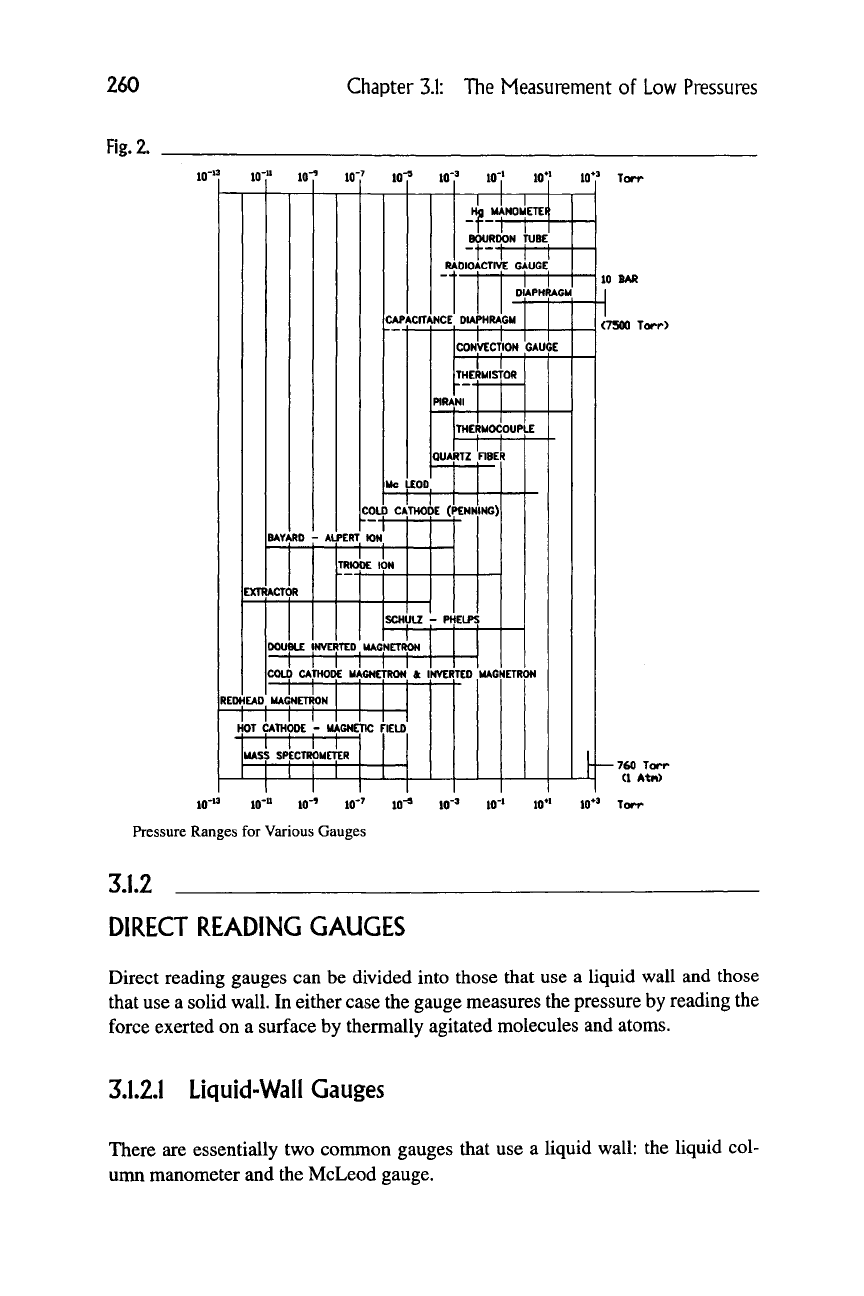
260
Chapter
3.1:
The
Measurement
of Low
Pressures
Fig.
2.
10"*'
10"" 107 10? 10"? 10"^ 10"» 107 10? Torr
CAPACITANCE DIAPHRAGM
I ^ I .
MANOMETElt
-V
BOURDON TUBE
RADIOACTIVE GAUGE
CONVECTION GAUGE
THERMISTOR
PIRANI
THERMOCOUPLE
QUARTZ
COLO CATHODE (PENNING)
SCHULZ - PHELPS
DOUBU INVERTED MAGNETRON
[COLD CATHODE MAGNETRON ft INVERTED MAGNETRON
REDHEAD MAGNETRON
HOT CATHODE - MAGNETIC FIELD
MASS SPECTROMETER
H-
760 Torr
(1 Atn)
10-»3 10"" 10"* 10"^ 10
*
Pressure Ranges for Various Gauges
3.1.2
DIRECT READING GAUGES
Direct reading gauges can be divided into those that use a liquid wall and those
that use a solid wall. In either case the gauge measures the pressure by reading the
force exerted on a surface by thermally agitated molecules and atoms.
3.1.2.1
Liquid-Wall Gauges
There are essentially two common gauges that use a liquid wall: the liquid col-
unm manometer and the McLeod gauge.
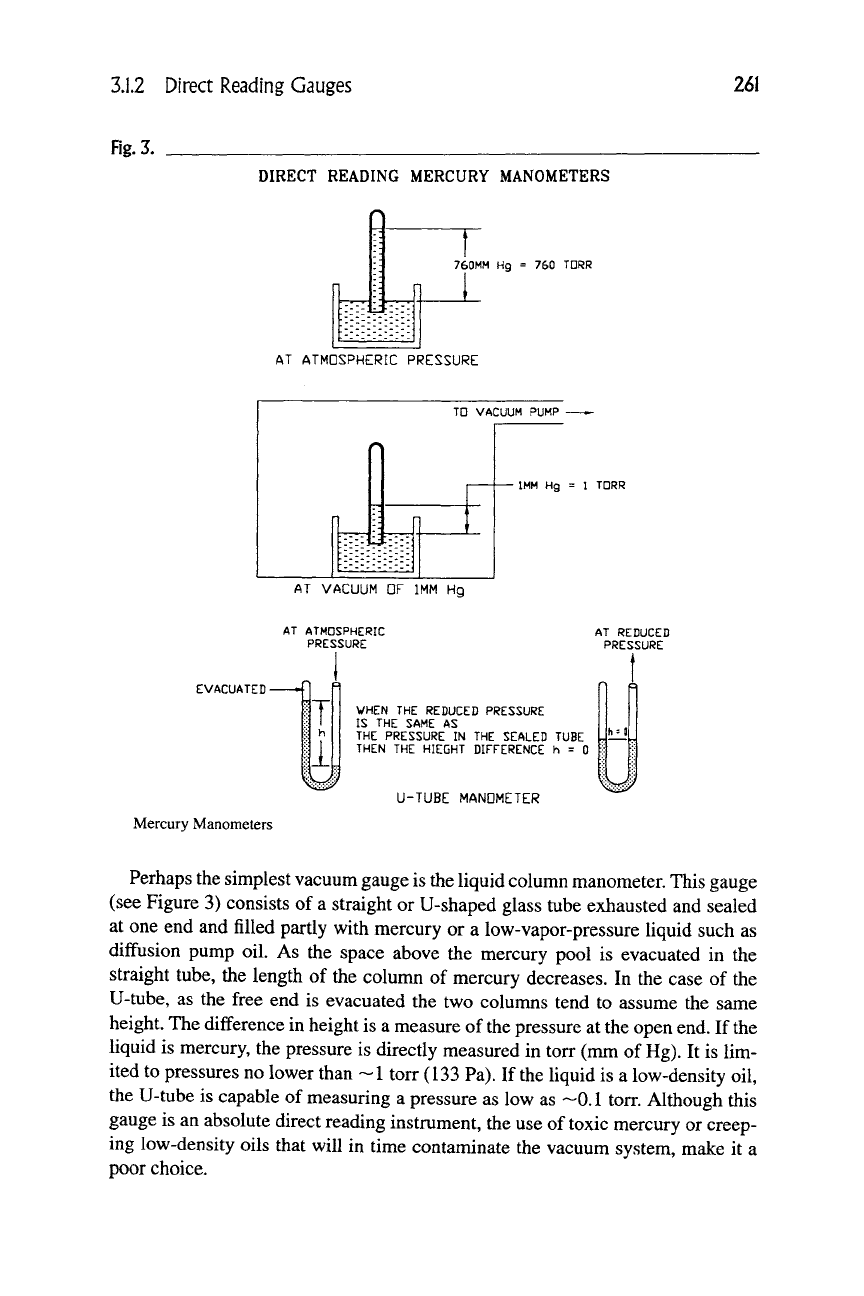
3.1.2 Direct Reading Gauges
261
Fig.
3.
DIRECT READING MERCURY MANOMETERS
760MM
Hg = 760
TDRR
AT ATMOSPHERIC PRESSURE
TD VACUUM PUMP •
•
IMM
Hg = 1
TDRR
AT VACUUM DF IMM Hg
AT ATMOSPHERIC
PRESSURE
AT REDUCED
PRESSURE
EVACUATED-
h
1
WHEN
THE
REDUCED PRESSURE
IS
THE
SAME
AS
THE PRESSURE
IN
THE
SEALED TUBE
THEN
THE
HIEGHT DIFFERENCE
h = 0
U-TUBE MANOMETER
%#
Mercury Manometers
Perhaps the simplest vacuum gauge is the liquid column manometer. This gauge
(see Figure 3) consists
of
a straight or U-shaped glass tube exhausted and sealed
at one end and filled partly with mercury
or a
low-vapor-pressure liquid such
as
diffusion pump oil.
As the
space above
the
mercury pool
is
evacuated
in
the
straight tube, the length
of
the column
of
mercury decreases.
In
the case
of
the
U-tube,
as
the free end
is
evacuated the two columns tend
to
assume
the
same
height. The difference in height is a measure of
the
pressure at the open end. If the
liquid is mercury, the pressure is directly measured in torr (mm
of
Hg).
It
is lim-
ited to pressures no lower than ~1 torr (133 Pa).
If
the liquid is
a
low-density oil,
the U-tube is capable
of
measuring
a
pressure as low as —0.1 torr. Although this
gauge is an absolute direct reading instrument, the use of toxic mercury or creep-
ing low-density oils that will
in
time contaminate the vacuum system, make
it a
poor choice.

262
Chapter
3.1:
The Measurement of Low Pressures
Rg.4.
CDMPRESSIDN
RATIO « 10*7
TD VACUUM
PUMP
Hg INLET
lOMM
Hg ON
GAUGE
10"^
MM ACTUAL
10-6
MM
X 10*7 = lOMM
TD VACUUM
PUMP
Hg INLET
McLeod Gauge
Due to the pressure limitation of the U-tube manometer the McLeod gauge [2]
was developed. Using Boyle's law, this gauge greatly increased the range of vac-
uum measurement (see Figure 4). It uses a mercury manometer in which a vol-
ume of gas is compressed before measurement. The sensitivity of the McLeod
gauge may be increased by increasing the compressible volume or by decreasing
the diameter of the compression capillary. However, if the compression volume is
too large, the weight of the mercury required to fill it sets a limit. If the capillary
is made too small, the mercury will stick to the walls. These restrictions challenge
the glass-blower's art
[3].
This device when used in a liquid-nitrogen-trapped sys-
tem by an experienced person, can be used as a primary standard. If
as
in Figure 4
the gas is at 10"^ torr and there is a compression ratio of 10^, the difference
between the colunms will be 10 mm. The fragility of the glass and toxicity of
the mercury argue against use by any but those skilled and careful individuals
interested in a relatively inexpensive standard. Unless precautions such as liquid
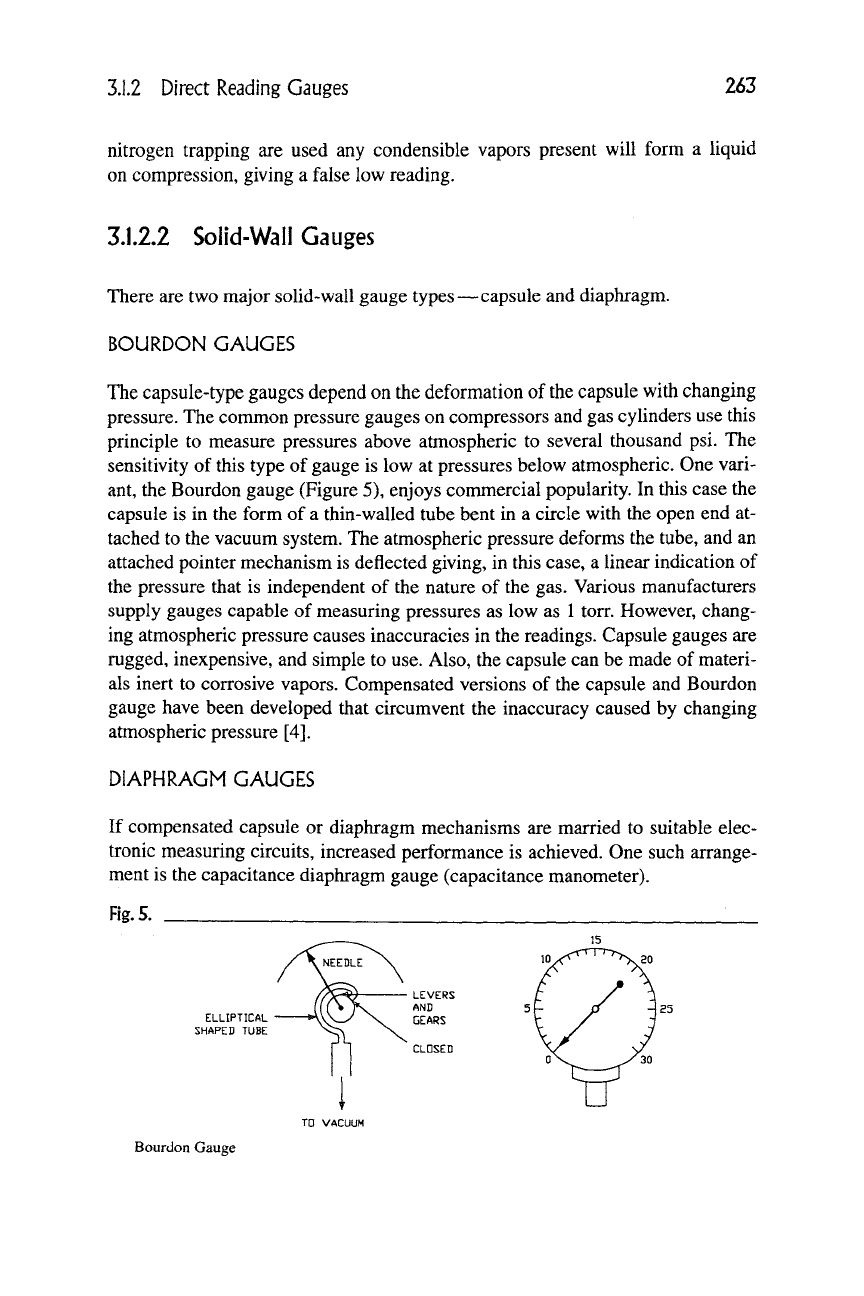
3.1.2 Direct Reading Gauges 263
nitrogen trapping are used any condensible vapors present will form a liquid
on compression, giving a false low reading.
3.1.2.2
Solid-Wall Gauges
There are two major solid-wall gauge types—capsule and diaphragm.
BOURDON GAUGES
The capsule-type gauges depend on the deformation of the capsule with changing
pressure. The common pressure gauges on compressors and gas cylinders use this
principle to measure pressures above atmospheric to several thousand psi. The
sensitivity of this type of gauge is low at pressures below atmospheric. One vari-
ant, the Bourdon gauge (Figure 5), enjoys commercial popularity. In this case the
capsule is in the form of a thin-walled tube bent in a circle with the open end at-
tached to the vacuum system. The atmospheric pressure deforms the tube, and an
attached pointer mechanism is deflected giving, in this case, a linear indication of
the pressure that is independent of the nature of the gas. Various manufacturers
supply gauges capable of measuring pressures as low as 1 torr. However, chang-
ing atmospheric pressure causes inaccuracies in the readings. Capsule gauges are
rugged, inexpensive, and simple to use. Also, the capsule can be made of materi-
als inert to corrosive vapors. Compensated versions of the capsule and Bourdon
gauge have been developed that circumvent the inaccuracy caused by changing
atmospheric pressure [4].
DIAPHRAGM GAUGES
If compensated capsule or diaphragm mechanisms are married to suitable elec-
tronic measuring circuits, increased performance is achieved. One such arrange-
ment is the capacitance diaphragm gauge (capacitance manometer).
Fig.
5.
ELLIPTICAL
SHAPED TUBE
Bourdon Gauge
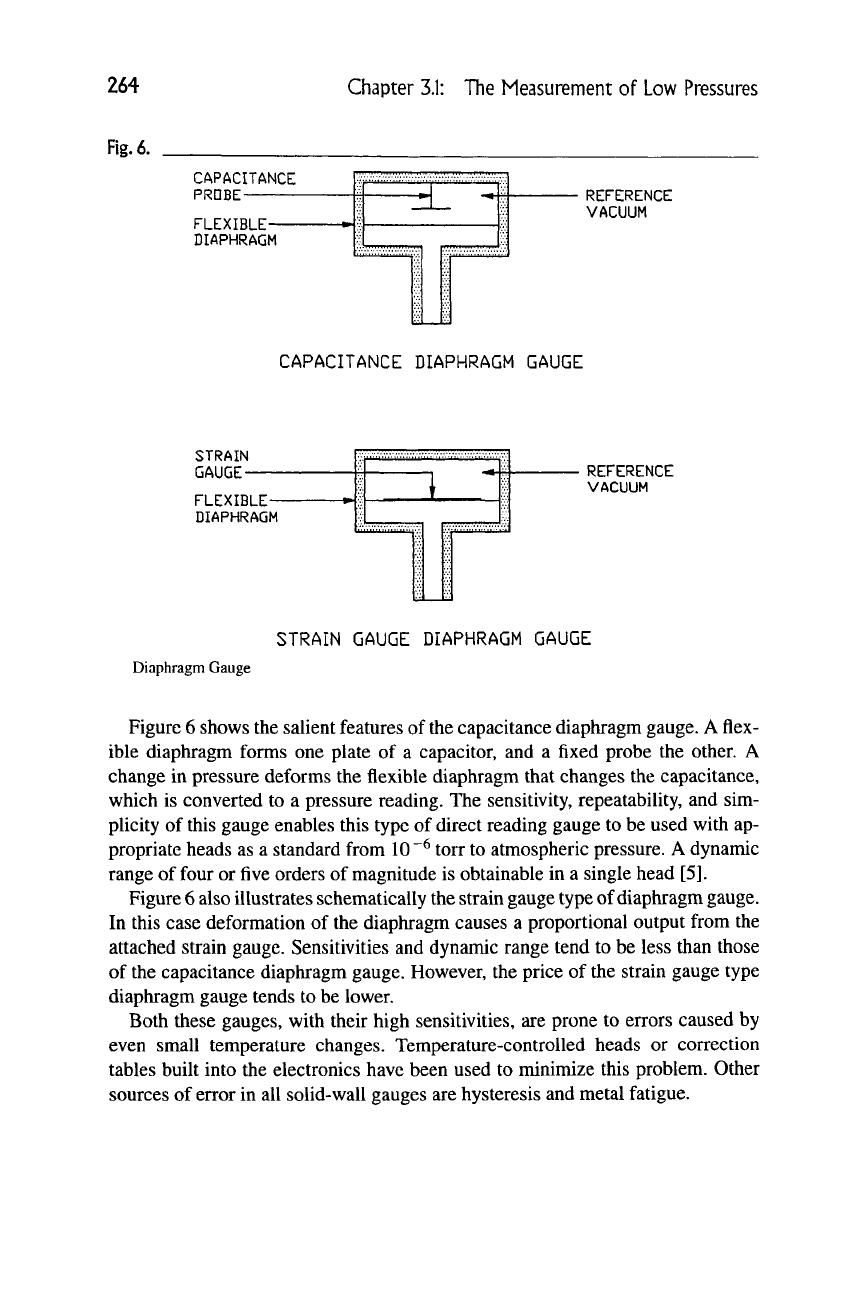
264
Fig.
6.
Chapter
3.1:
The Measurement of Low Pressures
CAPACITANCE
PRDBE
FLEXIBLE-
DIAPHRAGM
REFERENCE
VACUUM
CAPACITANCE DIAPHRAGM GAUGE
STRAIN
GAUGE-
FLEXIBLE—
DIAPHRAGM
REFERENCE
VACUUM
STRAIN GAUGE DIAPHRAGM GAUGE
Diaphragm Gauge
Figure 6 shows the salient features of the capacitance diaphragm gauge. A flex-
ible diaphragm forms one plate of a capacitor, and a fixed probe the other. A
change in pressure deforms the flexible diaphragm that changes the capacitance,
which is converted to a pressure reading. The sensitivity, repeatability, and sim-
plicity of this gauge enables this type of direct reading gauge to be used with ap-
propriate heads as a standard from 10"^ torr to atmospheric pressure. A dynamic
range of four or five orders of magnitude is obtainable in a single head [5].
Figure 6 also illustrates schematically the strain gauge type of diaphragm gauge.
In this case deformation of the diaphragm causes a proportional output from the
attached strain gauge. Sensitivities and dynamic range tend to be less than those
of the capacitance diaphragm gauge. However, the price of the strain gauge type
diaphragm gauge tends to be lower.
Both these gauges, with their high sensitivities, are prone to errors caused by
even small temperature changes. Temperature-controlled heads or correction
tables built into the electronics have been used to minimize this problem. Other
sources of error in all solid-wall gauges are hysteresis and metal fatigue.
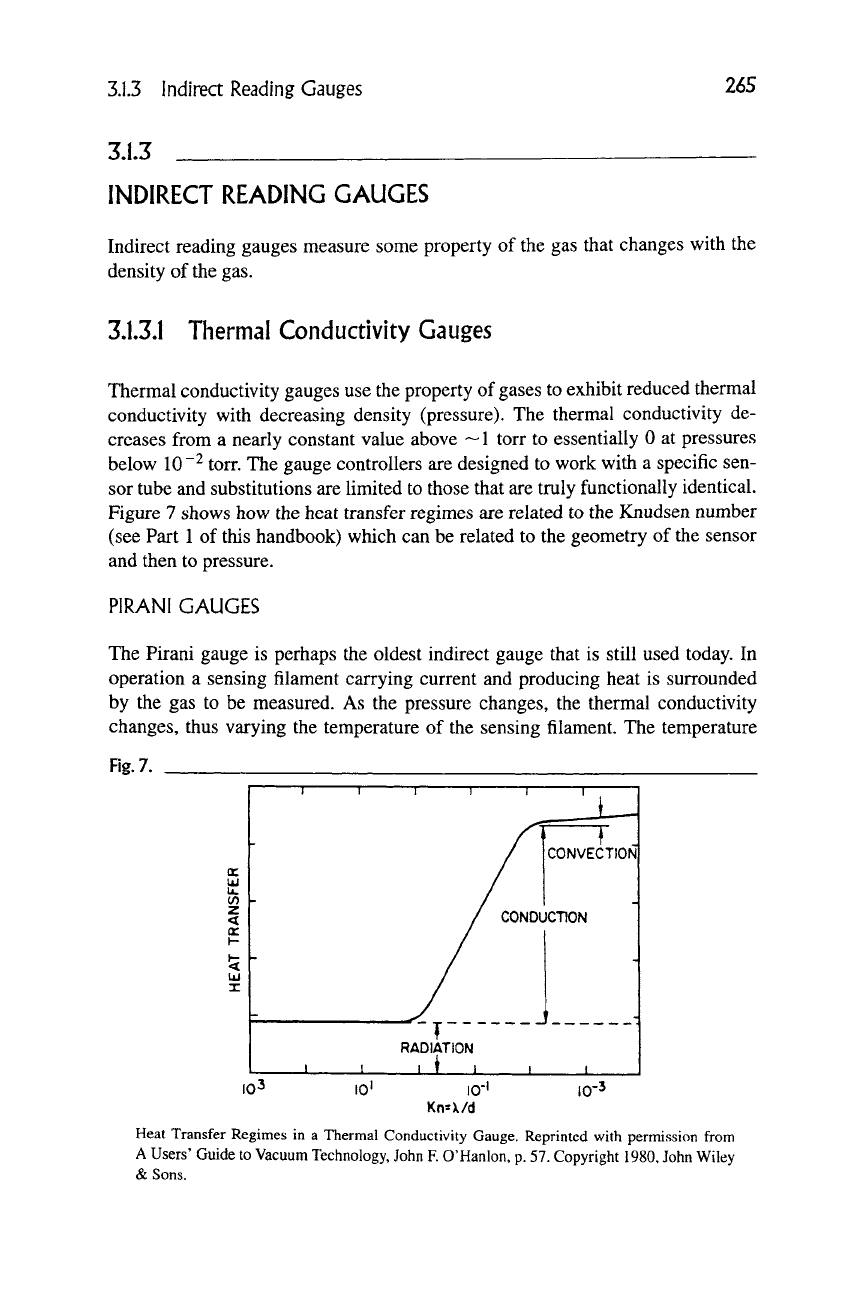
3.1.3 Indirect Reading Gauges
265
3.1.3
INDIRECT READING GAUGES
Indirect reading gauges measure some property of the gas that changes with the
density of the gas.
3.1.3.1 Thermal Conductivity Gauges
Thermal conductivity gauges use the property of gases to exhibit reduced thermal
conductivity with decreasing density (pressure). The thermal conductivity de-
creases from a nearly constant value above ~
1
torr to essentially 0 at pressures
below
10 ""^
torr. The gauge controllers are designed to work with a specific sen-
sor tube and substitutions are limited to those that are truly functionally identical.
Figure 7 shows how the heat transfer regimes are related to the Knudsen number
(see Part 1 of this handbook) which can be related to the geometry of the sensor
and then to pressure.
PIRANI GAUGES
The Pirani gauge is perhaps the oldest indirect gauge that is still used today. In
operation a sensing filament carrying current and producing heat is surrounded
by the gas to be measured. As the pressure changes, the thermal conductivity
changes, thus varying the temperature of the sensing filament. The temperature
Fig.
7.
UJ
U.
(/)
z
<
a:
5
UJ
I
I
• - • T 1 1—
RADIATION
1 1 -.1
, • .
1—
/^\
CONDI.
1 1
CONVECTION^
ICTION
1
1 J
_. 1 1
10^
10'
I0-'
Kn=X/d
10-3
Heat Transfer Regimes in a Thermal Conductivity Gauge. Reprinted with permission from
A Users' Guide to Vacuum Technology, John F. O'Hanlon, p. 57. Copyright 1980, John Wiley
& Sons.
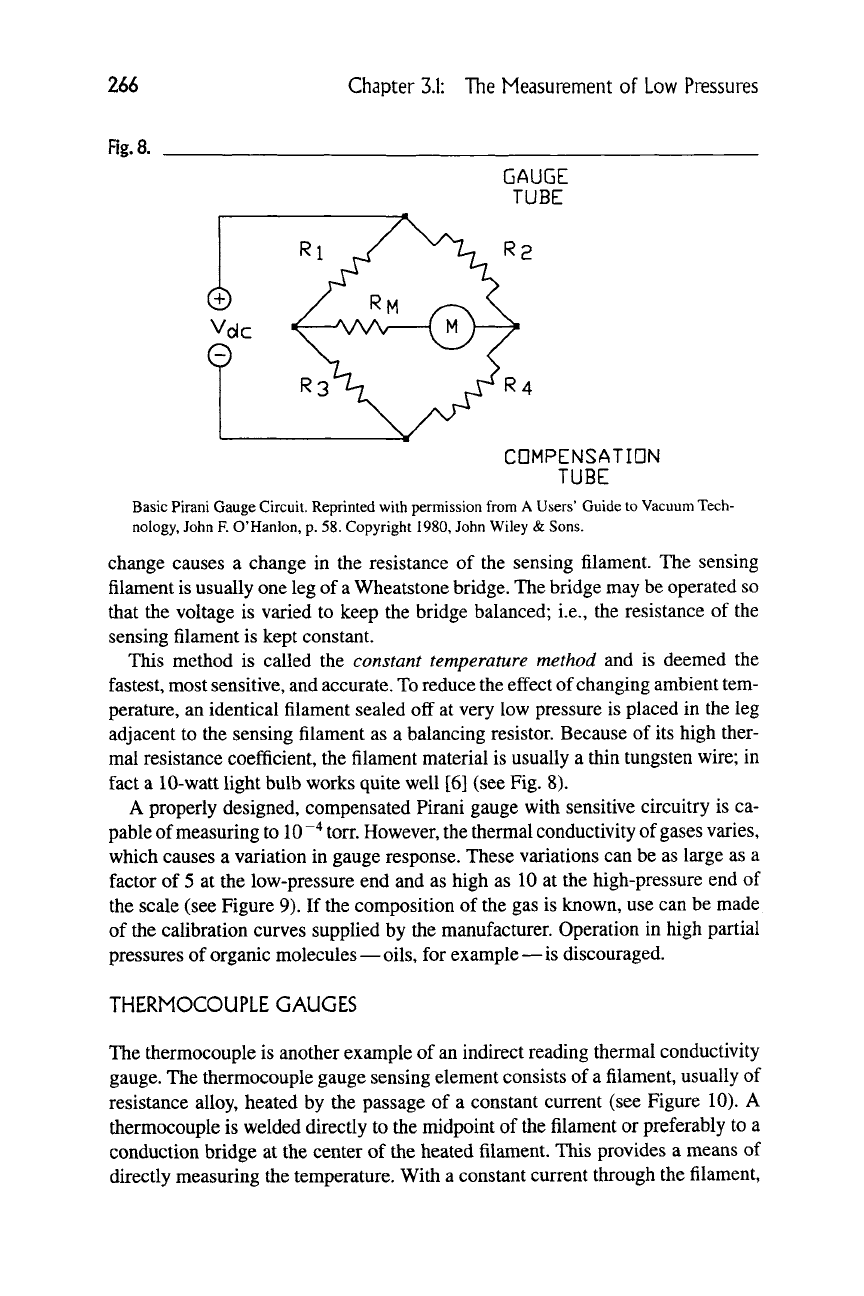
266
Chapter
3.1:
The
Measurement
of
Low Pressures
Rg.8.
GAUGE
TUBE
CDMPENSATIQN
TUBE
Basic Pirani Gauge Circuit. Reprinted with permission from A Users' Guide to Vacuum Tech-
nology, John F. O'Hanlon, p. 58. Copyright 1980, John Wiley & Sons.
change causes a change in the resistance of the sensing filament. The sensing
filament is usually one leg of a Wheatstone bridge. The bridge may be operated so
that the voltage is varied to keep the bridge balanced; i.e., the resistance of the
sensing filament is kept constant.
This method is called the constant temperature method and is deemed the
fastest, most sensitive, and
accurate.
To reduce the effect of changing ambient tem-
perature, an identical filament sealed off at very low pressure is placed in the leg
adjacent to the sensing filament as a balancing resistor. Because of its high ther-
mal resistance coefficient, the filament material is usually a thin tungsten wire; in
fact a 10-watt light bulb works quite well [6] (see Fig. 8).
A properly designed, compensated Pirani gauge with sensitive circuitry is ca-
pable of measuring to
10
""*
torr. However, the thermal conductivity of gases varies,
which causes a variation in gauge response. These variations can be as large as a
factor of 5 at the low-pressure end and as high as 10 at the high-pressure end of
the scale (see Figure 9). If the composition of the gas is known, use can be made
of the calibration curves supplied by the manufacturer. Operation in high partial
pressures of organic molecules—oils, for example—is discouraged.
THERMOCOUPLE GAUGES
The thermocouple is another example of an indirect reading thermal conductivity
gauge. The thermocouple gauge sensing element consists of a filament, usually of
resistance alloy, heated by the passage of a constant current (see Figure 10). A
thermocouple is welded directly to the midpoint of the filament or preferably to a
conduction bridge at the center of the heated filament. This provides a means of
directly measuring the temperature. With a constant current through the filament.

3.1.3 Indirea Reading Gauges
267
Rg.9.
10-
10^
2 io3
UJ
a.
-J
<
ID
o I0»
1
1
„
k
-
PRESSURE (Torr)
2 I0-' 1
( I'M I ' '
> 1
> < '
1 1 1
1 1
1 1 1
1 1
1 1 1 1 1
1 Ar
jFREON ^
1 ico^^;;;;^/
' / / f^
\ J / J /j»0
HpO //My'
Ar ^
^\////y^y^
Kr^s,^
^^^V"""^
/^^^v^He
y^^^X^C^^^^^
^2
y/W/ ^"-C^FREON
z;^^^ 1 C02
^,...l.iL.ii ,
,.-L...
. t... Ill 1 1 i i
101 I02
I
1
I
•
T
I
/I III/
/ AIR /'-
y
^Ne"
-^ -
^^^
-
'
........,^^
'L
-
-
-
I02
10'
UJ
1 §
en
CO
UJ
I0-'
10-2
I0» 102 103
INDICATED PRESSURE (Pa)
10^
Calibration Curves for Pirani Gauge. Reprinted with permission from Leybold-Heraeus
G.M.b.H., Postfach 51 07 60,5000 Kohn, Germany.
the temperature increases as the pressure decreases. This happens because there
are fewer molecules surrounding the filament to carry the heat away. The thermo-
couple output voltage increases as a result of the increased temperature and is an
inverse indication of the pressure. The thermocouple gauge can be operated in the
constant temperature mode just like the Pirani gauge.
Fig. 10.
CONDUCTIVE
BRIDGE
THERMDCDUPLE
HEATER
Thermocouple Gauge
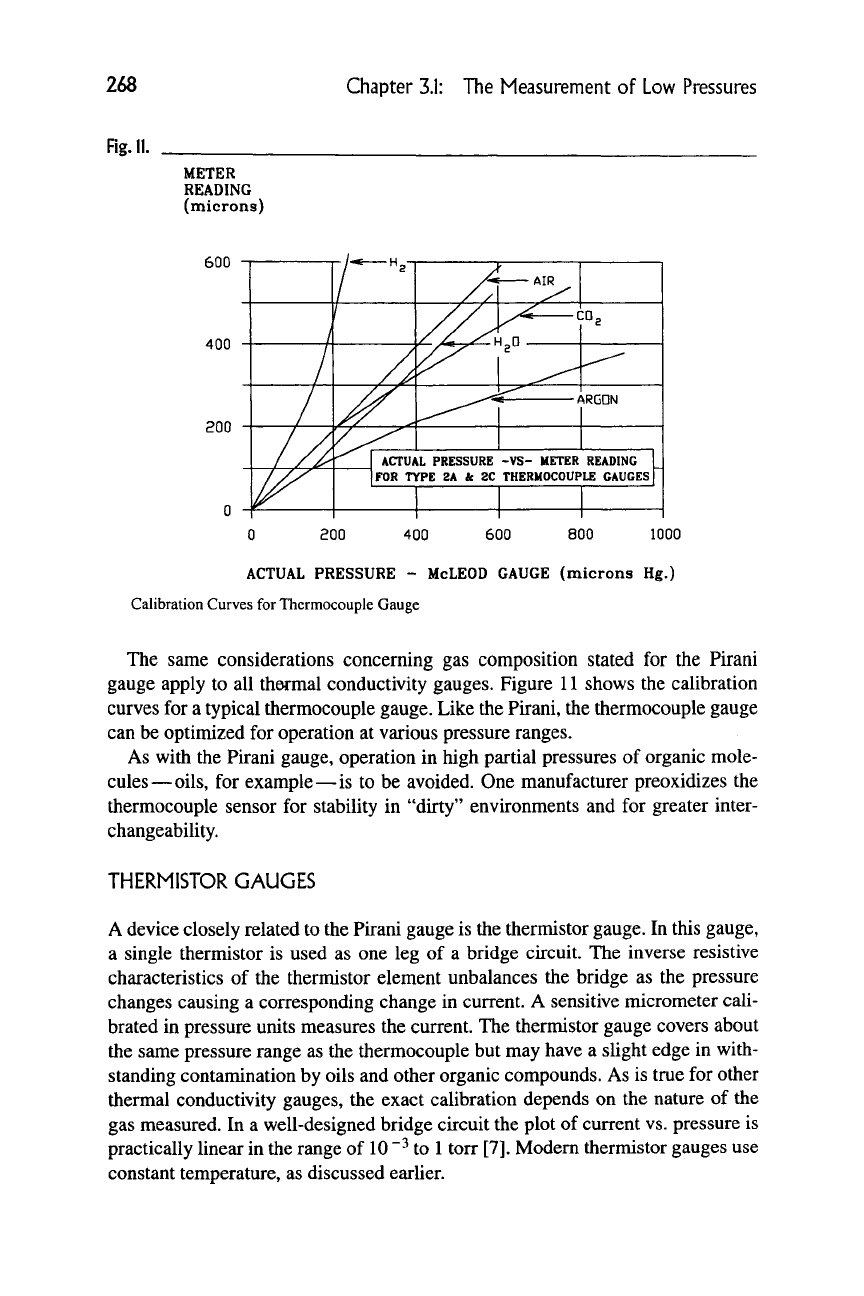
268
Chapter
3.1:
The Measurement of Low Pressures
Fig.
METER
READING
(microns)
600
400
200
200 400 600
800
1000
ACTUAL PRESSURE - McLEOD GAUGE (microns Hg.)
Calibration Curves for Thermocouple Gauge
The same considerations concerning gas composition stated for the Pirani
gauge apply to all thermal conductivity gauges. Figure 11 shows the calibration
curves for a typical thermocouple gauge. Like the Pirani, the thermocouple gauge
can be optimized for operation at various pressure ranges.
As with the Pirani gauge, operation in high partial pressures of organic mole-
cules—oils, for example—is to be avoided. One manufacturer preoxidizes the
thermocouple sensor for stability in "dirty" environments and for greater inter-
changeability.
THERMISTOR GAUGES
A device closely related to the Pirani gauge is the thermistor gauge. In this gauge,
a single thermistor is used as one leg of a bridge circuit. The inverse resistive
characteristics of the thermistor element unbalances the bridge as the pressure
changes causing a corresponding change in current. A sensitive micrometer cali-
brated in pressure units measures the current. The thermistor gauge covers about
the same pressure range as the thermocouple but may have a slight edge in with-
standing contamination by oils and other organic compounds. As is true for other
thermal conductivity gauges, the exact calibration depends on the nature of the
gas measured. In a well-designed bridge circuit the plot of current vs. pressure is
practically linear in the range of
10
"^ to
1
torr
[7].
Modem thermistor gauges use
constant temperature, as discussed earlier.
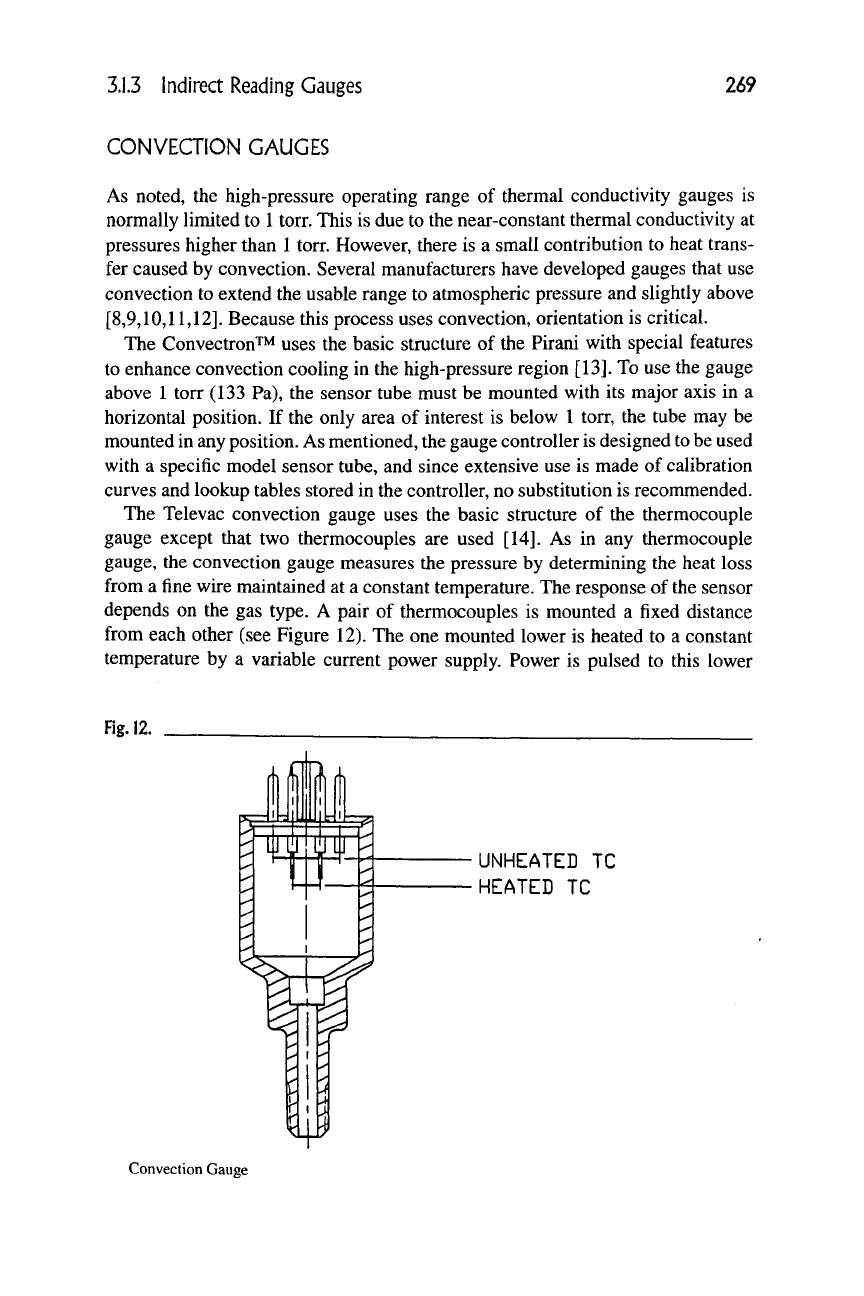
3.1.3 Indirect Reading Gauges
269
CONVECTION GAUGES
As noted, the high-pressure operating range of thermal conductivity gauges is
normally limited to
1
torr. This is due to the near-constant thermal conductivity at
pressures higher than 1 torr. However, there is a small contribution to heat trans-
fer caused by convection. Several manufacturers have developed gauges that use
convection to extend the usable range to atmospheric pressure and slightly above
[8,9,10,11,12].
Because this process uses convection, orientation is critical.
The ConvectronTM uses the basic structure of the Pirani with special features
to enhance convection cooling in the high-pressure region [13]. To use the gauge
above 1 torr (133 Pa), the sensor tube must be mounted with its major axis in a
horizontal position. If the only area of interest is below 1 torr, the tube may be
mounted in any position. As mentioned, the gauge controller
is
designed to be used
with a specific model sensor tube, and since extensive use is made of calibration
curves and lookup tables stored in the controller, no substitution is recommended.
The Televac convection gauge uses the basic structure of the thermocouple
gauge except that two thermocouples are used [14]. As in any thermocouple
gauge, the convection gauge measures the pressure by determining the heat loss
from a fine wire maintained at a constant temperature. The response of the sensor
depends on the gas type. A pair of thermocouples is mounted a fixed distance
from each other (see Figure 12). The one mounted lower is heated to a constant
temperature by a variable current power supply. Power is pulsed to this lower
Fig.
12.
¥
! !
I
UNHEATED TC
HEATED TC
^^s^
Convection Gauge
